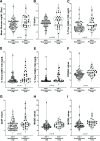CGM Metrics Identify Dysglycemic States in Participants From the TrialNet Pathway to Prevention Study
- PMID: 36730530
- PMCID: PMC10020029
- DOI: 10.2337/dc22-1297
CGM Metrics Identify Dysglycemic States in Participants From the TrialNet Pathway to Prevention Study
Abstract
Objective: Continuous glucose monitoring (CGM) parameters may identify individuals at risk for progression to overt type 1 diabetes. We aimed to determine whether CGM metrics provide additional insights into progression to clinical stage 3 type 1 diabetes.
Research design and methods: One hundred five relatives of individuals in type 1 diabetes probands (median age 16.8 years; 89% non-Hispanic White; 43.8% female) from the TrialNet Pathway to Prevention study underwent 7-day CGM assessments and oral glucose tolerance tests (OGTTs) at 6-month intervals. The baseline data are reported here. Three groups were evaluated: individuals with 1) stage 2 type 1 diabetes (n = 42) with two or more diabetes-related autoantibodies and abnormal OGTT; 2) stage 1 type 1 diabetes (n = 53) with two or more diabetes-related autoantibodies and normal OGTT; and 3) negative test for all diabetes-related autoantibodies and normal OGTT (n = 10).
Results: Multiple CGM metrics were associated with progression to stage 3 type 1 diabetes. Specifically, spending ≥5% time with glucose levels ≥140 mg/dL (P = 0.01), ≥8% time with glucose levels ≥140 mg/dL (P = 0.02), ≥5% time with glucose levels ≥160 mg/dL (P = 0.0001), and ≥8% time with glucose levels ≥160 mg/dL (P = 0.02) were all associated with progression to stage 3 disease. Stage 2 participants and those who progressed to stage 3 also exhibited higher mean daytime glucose values; spent more time with glucose values over 120, 140, and 160 mg/dL; and had greater variability.
Conclusions: CGM could aid in the identification of individuals, including those with a normal OGTT, who are likely to rapidly progress to stage 3 type 1 diabetes.
© 2023 by the American Diabetes Association.
Conflict of interest statement
Figures




References
-
- Kovatchev BP. Metrics for glycaemic control—from HbA1c to continuous glucose monitoring. Nat Rev Endocrinol 2017;13:425–436 - PubMed
-
- Verge CF, Gianani R, Kawasaki E, et al. . Prediction of type I diabetes in first-degree relatives using a combination of insulin, GAD, and ICA512bdc/IA-2 autoantibodies. Diabetes 1996;45:926–933 - PubMed

